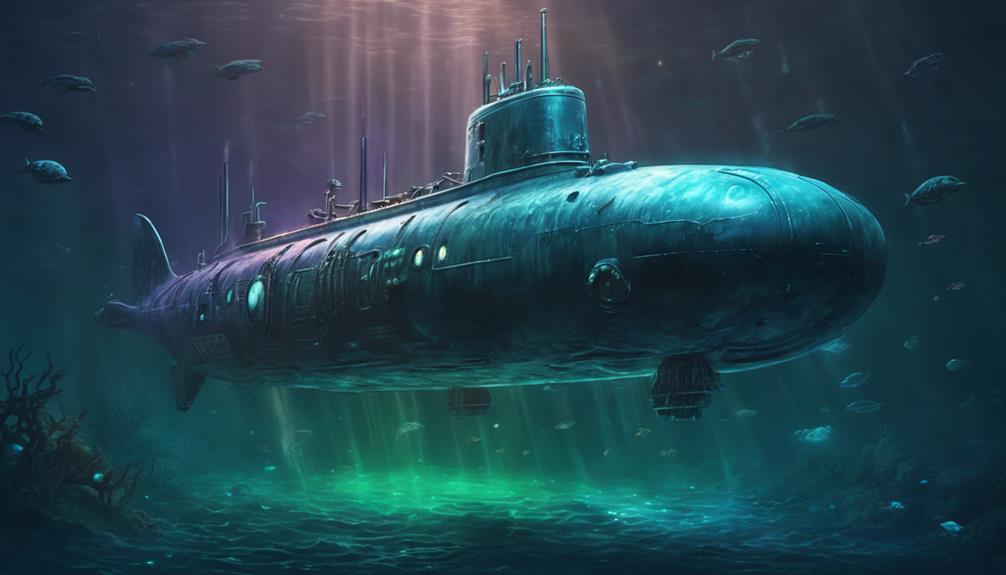Submarines, marvels of engineering, delve into the depths of the ocean with precision and expertise. Equipped with sophisticated technology, these vessels navigate the underwater world with a blend of mechanical prowess and human ingenuity. From their unique design features to the intricacies of life support and propulsion systems, submarines represent a fascinating intersection of science and exploration. As we uncover the layers of complexity that define how submarines operate beneath the waves, a deeper understanding emerges of the mysteries waiting to be unraveled in the uncharted territories of the deep sea.
Key Takeaways
- Submarines use advanced technologies like radar and sonar for underwater exploration.
- Nuclear-powered propulsion systems enable submarines to reach unprecedented depths and durations.
- Design features like double hulls and pressure resistance mechanisms ensure structural integrity and safety.
- Submarines face challenges of limited visibility, strong currents, and the need for autonomous underwater vehicles for enhanced exploration.
History of Submarines
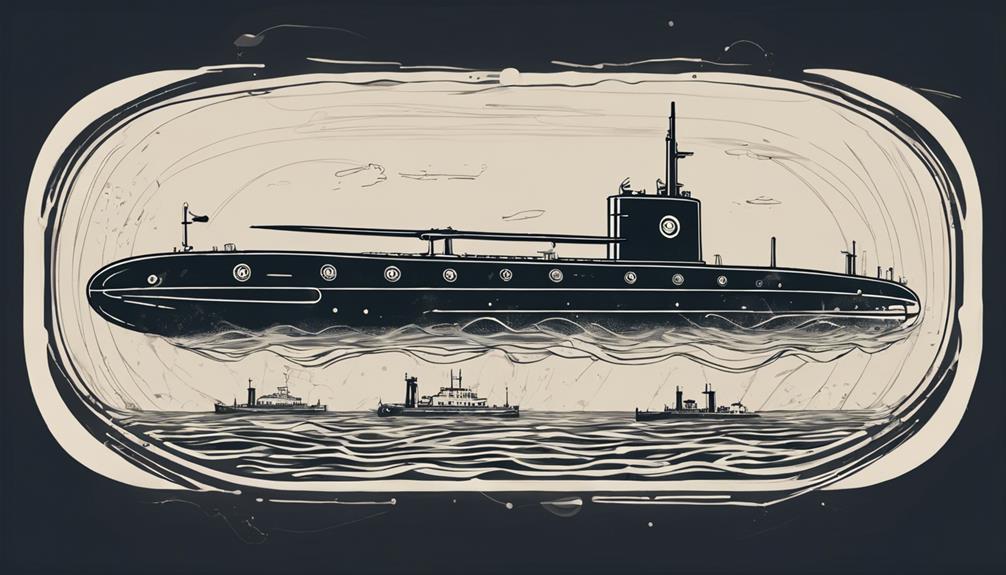
Dating back to ancient times, the history of submarines reveals a progression of innovative designs and technological advancements that have revolutionized naval warfare and underwater exploration. During the American Civil War, the Confederates introduced the CSS Hunley, a submarine powered by human propulsion. This marked one of the first instances of submarines being used in combat. Moving forward, the introduction of diesel engines in submarines brought about a significant shift in propulsion technology. The French submarine Aigrette, launched in 1904, was the first to utilize a diesel-electric engine, setting the stage for modern submarine propulsion systems.
Moreover, the exploration of the Challenger Deep, the deepest known point in the Earth's seabed, demonstrated the capability of submarines to reach extreme depths for scientific research and discovery. These milestones in submarine history highlight the continuous evolution of underwater vessels from early experimental designs to powerful and sophisticated naval assets.
Evolution of Submarine Technology
The evolution of submarine technology has been marked by significant advancements that have revolutionized underwater exploration. Technological progress, such as improvements in radar and sonar systems, has greatly enhanced the detection capabilities and navigation precision of submarines. From early hand-cranked models to modern nuclear-powered submarines, the evolution of this technology has enabled longer submersion periods and greater defense capabilities.
Technological Advancements in Submarines
Advancing through pivotal historical events, submarine technology has undergone a remarkable evolution, culminating in sophisticated capabilities for extended underwater exploration and defense. The bathyscaphe Trieste, under Auguste Piccard's guidance, set records by descending into the depths of the Marianas Trench, showcasing early deep-sea exploration achievements. Transitioning from hand-cranked mechanisms to nuclear-powered propulsion systems marked a significant leap in submarines' submersion capabilities, allowing for longer missions and enhanced power. The development of nuclear-powered submarines revolutionized underwater warfare and exploration, providing unparalleled endurance and speed beneath the ocean's surface. These technological advancements, spurred by historical milestones like the Marianas Trench exploration and the introduction of nuclear power, continue to shape the landscape of underwater exploration and defense, pushing boundaries for further innovation in submarine technology.
Impact on Underwater Exploration
Building upon the historical foundation of technological advancements in submarines, the evolution of submarine technology has profoundly impacted underwater exploration by expanding the capabilities and reach of deep-sea missions. This impact is evident through the United States' submarines setting records by reaching the deepest point in the ocean. Advancements from hand-cranked submarines to nuclear-powered ones have revolutionized the duration and depth of underwater missions, enabling longer and deeper explorations. Submarines have played crucial roles in historical events such as World Wars, and they continue to enhance marine science through advanced technologies. Continuous advancements in submarine technology aim to push the boundaries of underwater exploration for scientific research and defense purposes.
Submarine Design and Structure
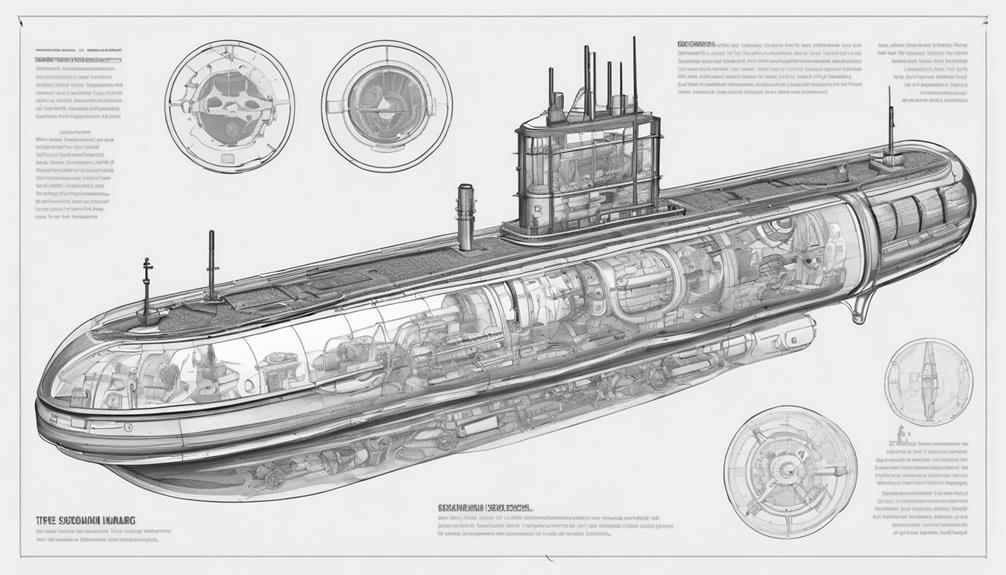
Submarines are meticulously engineered with double hulls to ensure structural integrity under immense underwater pressures. The outer hull acts as a shield against the harsh marine environment, safeguarding the inner hull where the crew operates and essential systems are housed. Components such as ballast tanks, trim tanks, and diving planes play crucial roles in controlling the submarine's buoyancy, stability, and maneuverability.
Hull Materials
Steel, titanium, and composite materials are commonly utilized as hull materials in submarine design to ensure structural integrity and withstand the high pressures experienced underwater. Steel hulls are favored for their strength and cost-effectiveness, while titanium hulls offer a superior strength-to-weight ratio, ideal for deep-diving submarines. Composite materials, such as carbon fiber reinforced polymers, provide both strength and corrosion resistance, making them suitable for specialized submarine applications. The choice of hull material is crucial and depends on various factors like depth requirements, durability needs, and cost considerations in the overall submarine design process.
- Steel hulls: Common for strength and cost-effectiveness.
- Titanium hulls: High strength-to-weight ratio, ideal for deep-diving.
- Composite materials: Provide strength and corrosion resistance.
- Factors influencing choice: Depth requirements, durability, and cost.
Pressure Resistance
To ensure the structural integrity and safety of submarines during deep-sea exploration, the design and construction of these vessels prioritize robust pressure resistance mechanisms within their hulls. Submarines are built with strong, pressure-resistant hulls typically made of high-strength steel or titanium to withstand the immense pressure of the ocean as they descend to greater depths. The hulls prevent collapse and maintain the integrity of the vessel. These vessels utilize ballast tanks to control buoyancy, enabling them to dive and resurface by adjusting water and air levels in the tanks. Pressure resistance is a critical aspect of submarine design, ensuring the safety and functionality of the vessel as it navigates various ocean depths. Years later, submarines continue to be powered by diesel, with advancements in technology enhancing their capabilities in underwater exploration.
How Submarines Submerge and Surface
Utilizing a sophisticated system of ballast tanks, submarines facilitate their submersion and surfacing maneuvers with precise control over water levels. This process involves taking in water to increase weight for submersion and expelling water using compressed air to rise to the surface. Submarines can adjust their depth by regulating the amount of water in the ballast tanks. When it comes to surfacing, submarines release the water from the ballast tanks by pumping in air, which increases buoyancy and allows the vessel to rise. This meticulous management of water levels in the ballast tanks is crucial for the effective submersion and surfacing of submarines.
- Submarines submerge by taking in water into ballast tanks to increase weight.
- The water in the ballast tanks is expelled using compressed air to make the submarine rise.
- Submarines control their depth by adjusting the amount of water in the ballast tanks.
- To surface, submarines release the water in the ballast tanks by pumping in air.
- This process of adjusting water levels in ballast tanks allows submarines to submerge and surface effectively.
Life Inside a Submarine

What conditions govern the daily existence of crew members inside a submarine, and how do they adapt to the challenges of living in such confined spaces? Living inside a submarine presents unique challenges due to limited space, with crew members often working and residing in close quarters. Crew dynamics play a crucial role in maintaining a harmonious environment, as individuals must navigate shared living spaces and cooperate effectively. The living conditions are characterized by a strict schedule that dictates tasks, meal times, and rest periods to optimize efficiency and ensure the well-being of the crew.
Psychological effects are also significant in the submarine environment, as isolation and prolonged periods underwater can impact individuals differently. To mitigate these effects, crew members undergo rigorous training to prepare them for the psychological challenges they may face. Additionally, specialized ventilation systems are in place to maintain air quality and prevent the accumulation of carbon dioxide, contributing to the overall well-being of the crew. Communication within the submarine is essential, often relying on intercom systems due to the confined nature of the environment. Crew members must adapt to this unique way of life, relying on teamwork and training to navigate the complexities of living and working underwater.
Navigation and Communication Underwater
Navigating the vast underwater expanses poses unique challenges for submarines, requiring advanced sonar systems to detect surroundings and inertial navigation combined with GPS data to accurately determine their position.
- Underwater topography mapping: Submarines use sonar systems to map the seabed and detect underwater obstacles, enabling safe navigation in unknown territories.
- Acoustic communication: Due to the inefficiency of radio waves underwater, submarines rely on acoustic signals to communicate with other vessels or command centers, utilizing sound waves for long-distance transmissions.
- Navigation challenges: Submarines face difficulties such as limited visibility, strong currents, and the absence of GPS signals underwater, necessitating sophisticated navigation systems for precise maneuvering.
- Inertial navigation systems: Submarines employ gyroscopes and accelerometers to maintain course and heading accuracy, especially in challenging underwater conditions where traditional GPS signals may be unavailable.
- Integration of GPS data: Near the surface, submarines combine GPS data with inertial navigation systems to enhance positioning accuracy, ensuring precise navigation while submerged.
Sonar Systems for Underwater Exploration
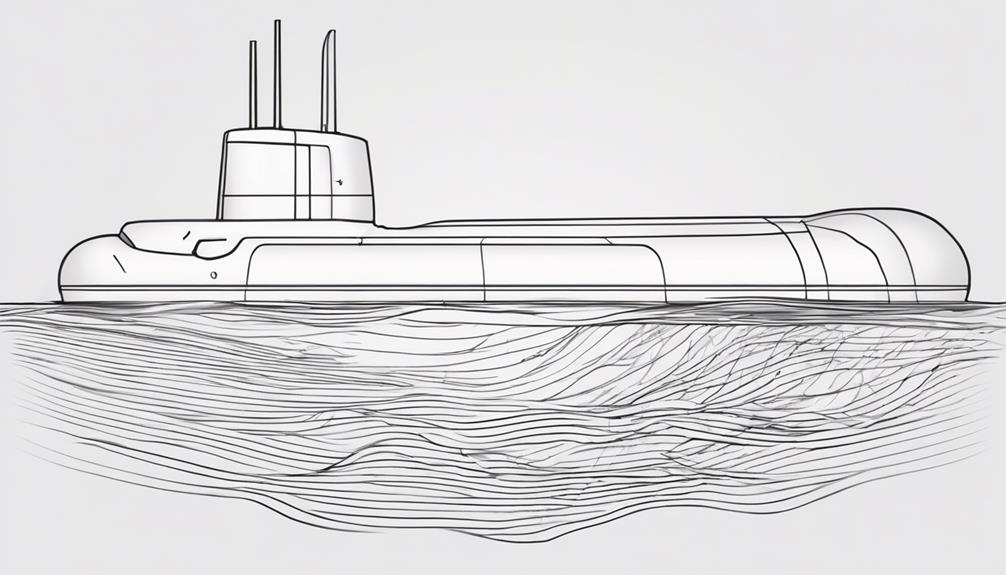
Underwater exploration relies heavily on advanced sonar systems to detect objects and map the underwater environment with precision. Sonar systems on submarines utilize underwater acoustics to emit sound pulses that bounce off objects, providing crucial information for sonar mapping in the deep sea. By analyzing the time taken for these sound waves to return, submarines can determine the distance, size, and shape of underwater objects accurately. This hydrophone technology is essential for ocean surveillance, enabling submarines to navigate effectively in dark and murky waters where visibility is limited. Moreover, sonar technology plays a vital role in detecting marine life and classifying different types of underwater targets with high accuracy. The table below highlights key aspects of sonar systems in underwater exploration:
| Key Aspect | Description | Importance |
|---|---|---|
| Underwater Acoustics | Utilizes sound waves for object detection | Essential for navigation |
| Sonar Mapping | Generates sonar images for mapping underwater | Crucial for exploration |
| Hydrophone Technology | Detects marine life and underwater targets | Critical for ocean surveillance |
Role of Submarines in Ocean Research
Submarines have become indispensable tools for conducting comprehensive ocean research due to their capability to collect crucial data on various aspects of the marine environment. They play a vital role in exploring the depths of the ocean and understanding its complexities. Here are some key roles submarines play in ocean research:
- Deep sea discoveries: Submarines enable scientists to explore deep-sea environments that are otherwise unreachable. They facilitate the discovery of new species, geological formations, and ecosystems hidden in the depths of the ocean.
- Underwater ecosystems: Submarines provide researchers with a unique opportunity to study underwater ecosystems in their natural habitat. They help in unraveling the intricate relationships between different marine organisms and their environments.
- Marine biodiversity: By conducting surveys and observations, submarines contribute to the documentation of marine biodiversity. They aid in identifying new species, monitoring population dynamics, and assessing the health of marine ecosystems.
- Data collection: Submarines collect essential data on ocean conditions, marine life, and geological features during research missions. This data is instrumental in advancing our understanding of the ocean and its inhabitants.
- Climate change research: Submarines play a crucial role in studying the effects of climate change on marine environments. They provide valuable insights into how these changes impact underwater ecosystems and biodiversity.
Challenges of Underwater Exploration
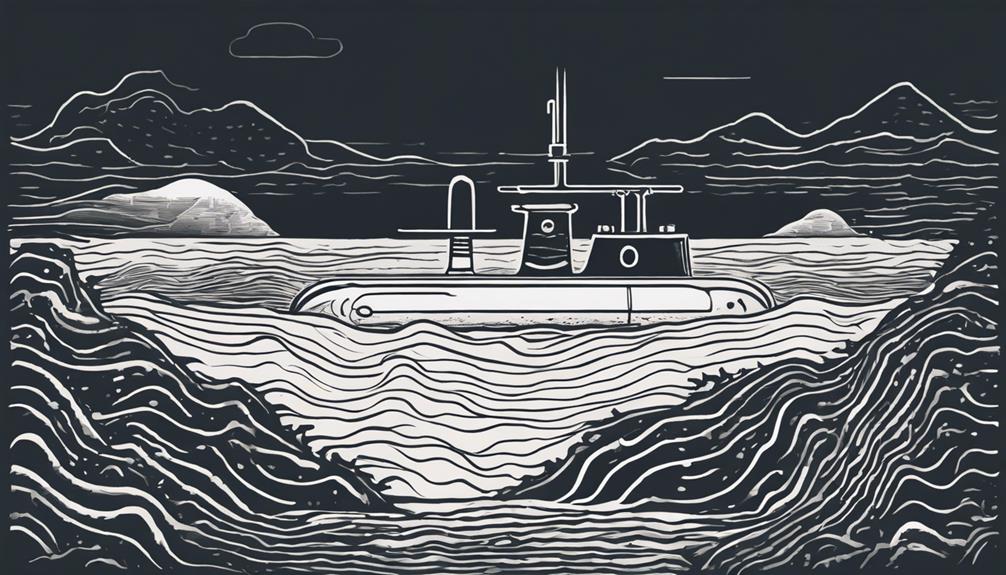
Exploring the depths of the ocean presents a myriad of challenges, including coping with the escalating pressure as one descends into the abyss. The lack of visibility beyond certain depths compounds the difficulty of navigating and conducting research in these environments. Additionally, maintaining effective communication becomes increasingly arduous as divers venture further into the deep, requiring innovative solutions to overcome these obstacles.
Depth Pressure Challenges
The challenges posed by depth pressure in oceanic environments present formidable obstacles that necessitate specialized engineering solutions for successful deep-sea exploration missions.
- Pressure increases by one atmosphere every 10 meters depth in the ocean, creating immense challenges for underwater exploration.
- Deep-sea submarines must withstand pressures exceeding 1,000 times that at the surface, requiring specialized materials and engineering.
- The crushing pressure at deep ocean depths can crush ordinary materials and even implode structures not designed to withstand such forces.
- Submersibles exploring the deep ocean must have strong, reinforced hulls and advanced engineering to prevent collapse under extreme pressure.
- Engineers designing deep-sea exploration vehicles must consider the effects of pressure on all components to ensure safe and successful underwater missions.
Limited Visibility Obstacles
Limited visibility in deep-sea environments presents a significant challenge for comprehensive underwater research and exploration missions. Submarines encounter underwater visibility challenges due to darkness at certain depths, hindering observation. To overcome this obstacle, submarines utilize sonar navigation techniques and imaging technology advancements. Sonar systems emit sound waves that bounce off objects, allowing submarines to navigate and map their surroundings even in low visibility conditions. The advancements in imaging technology have significantly enhanced the ability of submarines to explore and study environments where natural light cannot penetrate. Deep-sea exploration necessitates specialized equipment on submarines to ensure safe and effective operations despite limited visibility, enabling researchers to gather data and images essential for underwater research.
| Underwater Visibility Challenges | Sonar Navigation Techniques | Imaging Technology Advancements |
|---|---|---|
| Darkness hinders observation at depths | Sonar systems emit sound waves for navigation | Advancements improve exploration capabilities |
Communication Difficulties Underwater
Navigating the depths of the ocean poses significant challenges for underwater researchers and explorers, particularly when it comes to communication difficulties underwater.
- Sound Travel in Water: Sound travels faster and farther in water than in air, but faces distortion, absorption, and reflection underwater.
- Frequency Limitations: High-frequency signals are absorbed quickly, limiting communication range, while low-frequency sounds can travel long distances.
- Acoustic Modems: Underwater vehicles use acoustic modems to communicate through sound waves, overcoming traditional radio frequency limitations.
- Transmission Challenges: Signal attenuation and multipath propagation hinder data transmission underwater, requiring specialized communication protocols.
- Advancements: Ongoing research focuses on acoustic signal processing, adaptive modulation, and underwater acoustic networks to enhance communication reliability and data transfer rates.
Future Trends in Submarine Technology
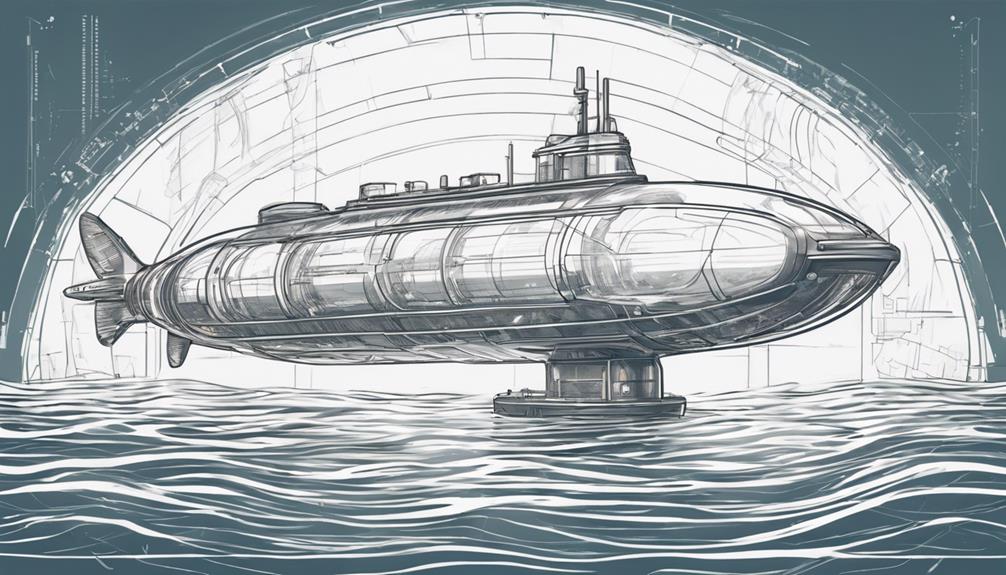
Amidst the rapid evolution of submarine technology, a notable trend on the horizon involves the development and integration of autonomous underwater vehicles (AUVs) to enhance exploration capabilities. These underwater drones are equipped with advanced sensors and navigation systems, allowing them to operate independently and gather valuable data in various underwater environments. Additionally, sustainable propulsion methods such as hydrogen fuel cells are being explored to reduce environmental impact and increase the operational range of submarines.
| Trends in Submarine Technology | Examples |
|---|---|
| Autonomous Underwater Vehicles (AUVs) | – Enhanced exploration capabilities <br> – Independent data collection |
| Sustainable Propulsion | – Hydrogen fuel cells for reduced environmental impact <br> – Extended operational range |
| Submarine Stealth Technology | – Advanced materials for improved efficiency <br> – Integration of AI for smarter decision-making |
These advancements, coupled with innovations in materials science and the integration of artificial intelligence, are revolutionizing the capabilities of submarines. The collaborative efforts among nations and research institutions further drive innovation, fostering international cooperation in underwater exploration and defense.
Environmental Impact of Submarine Exploration
Exploring the environmental ramifications of submarine exploration is paramount in ensuring the delicate balance between scientific inquiry and marine conservation efforts.
- Submarine exploration can have a minimal environmental impact due to their ability to operate without disturbing marine life.
- Sonar technology used by submarines to navigate underwater can be harmful to marine mammals like whales and dolphins.
- Submarines contribute to scientific research and conservation efforts by studying marine ecosystems and biodiversity.
- Proper disposal of waste and adherence to regulations help mitigate potential environmental impacts of submarine exploration.
- Understanding the environmental impact of submarine exploration is crucial for balancing scientific discovery with marine conservation efforts.
Frequently Asked Questions
How Do Submarines Travel Underwater?
Submarines travel underwater utilizing sophisticated propulsion systems that enable them to maneuver through the depths. By adjusting their buoyancy through precise control of ballast tanks and trim, submarines can navigate the underwater environment effectively. Deep sea exploration necessitates a mastery of underwater navigation techniques, including the management of buoyancy to control depth. Submarines employ a combination of water intake and expulsion, coupled with propulsion mechanisms, to traverse underwater terrains with precision and efficiency.
Can You Explore the Ocean in a Submarine?
Exploring the ocean depths in a submarine offers unparalleled opportunities for deep sea exploration, observation of underwater habitats, and studying marine life. Submarines provide a controlled environment for scientific research and discovery, allowing researchers to delve into the mysteries of the ocean's hidden world. Through advanced technology and meticulous planning, submarines facilitate crucial investigations that contribute to our understanding of the complex ecosystems that thrive beneath the ocean's surface.
How Does a Submarine Float at Times and Go Under Water at Other Times?
Buoyancy control in submarines is achieved through the strategic use of ballast tanks. By adjusting the amount of water in these tanks, submarines can float or submerge. When the tanks are filled with water, the submarine becomes denser than the surrounding water, causing it to descend. To resurface, compressed air is used to expel water from the tanks, decreasing the submarine's density and enabling it to rise. These pressure changes are fundamental to the submarine's ability to navigate underwater environments.
Is It Possible to Enter Submarine Under Water?
When considering the possibility of entering a submarine underwater, several critical factors come into play. Underwater ventilation systems are essential to maintain a breathable atmosphere within the vessel. Pressure adjustments must be carefully managed to ensure the safety and comfort of personnel during entry and exit procedures. Additionally, well-defined emergency procedures are in place to address any unexpected challenges that may arise during this delicate process.
Conclusion
In conclusion, submarines utilize advanced technology to explore the depths of the ocean, allowing for crucial research and exploration. Despite their importance in deep-sea exploration, submarines do pose environmental concerns due to their use of propulsion systems. However, ongoing advancements in submarine technology aim to mitigate these impacts and enhance the efficiency and sustainability of underwater exploration.
